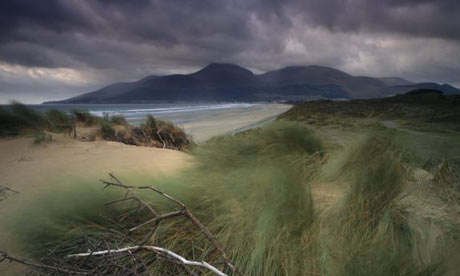Global warming brings big problems to Giant's Causeway

At Murlough Nature Reserve in County Down wetter winters and drier summers could put important dune and heath plants at risk as invasive scrub thrives Photograph: Paul Wakefield/National Trust
Northern Ireland's biggest tourist attraction, the Giant's Causeway, could fall victim to global warming, the National Trust warned today.
The province's only World Heritage site is threatened by rising water levels and coastal erosion, says a report for the trust, which is the guardian of the site.
The report, by Queen's University and the University of Ulster, warned that part of Middle and Little Causeway could be under water for much of the winter by the end of the century.
The Grand Causeway could also suffer serious erosion by 2080 and new approach routes for visitors would probably have to be built, it said.
In the shorter term, predicted stormier weather at the site over the next decade would require greater safety measures to be introduced to stop people falling from the cliff next to the famous octagonal basalt stones.
In the medium term – from 2050 to 2080 – many more of the stones will be under the waves.
The causeway is one of three of the trust's properties in the province that are threatened by water levels which could rise by a metre by the end of the century, the charity said.
Murlough national nature reserve and Strangford Lough, both in County Down, are also at risk from coastal erosion and flooding.
At Strangford Lough, sea levels are predicted to rise by 25cm by 2050 with a "worst case scenario" prediction of a one-metre rise by the turn of the century.
The Lough, which is internationally important for its birds and other wildlife, is designated a marine nature reserve and a special area of conservation.
The greater the sea level rise, the greater the loss of its important tidal mud flats. This would have a significant impact on the availability of food for the tens of thousands of Brent geese and other birds that winter there.
As more of the Lough's islands disappear under water, there would also be a detrimental impact on the summer breeding of seabirds, including terns, ringed plovers and cormorants, and the population of seals.
The Murlough reserve could see 50-400 metres of the existing dune frontage eroded away, together with a serious loss of vegetation.
The report, Shifting Shores: Living with a Changing Coastline, also highlights the challenges potentially facing all of Northern Ireland's coastline in decades to come.
Likely changes in Northern Ireland's climate highlighted in the report include:
• Warmer annual temperatures
• Wetter winters and drier summers
• Sea level rises of between 85 and 100 cm by 2100
• Increased frequency of extreme storm surges and of extreme waves.
The National Trust director for Northern Ireland, Hilary McGrady, called for government help to protect the coastline.
"Our planning system and, in particular, development plans and planning policy statements must take predicted coastal change into account to ensure coastal landscapes are adequately protected in the future," she said.
Professor Julian Orford, from Queen's University, who led the research, said: "Northern Ireland's coastline will be a changing, and indeed challenging, environment in the 21st century. The National Trust and many other bodies must prepare now to meet the uncertain challenges ahead."

No comments:
Post a Comment